As pet owners, we focus on the well-being of our furry friends, especially when it comes to the plants in our homes.
Cat owners face the challenge of ensuring their houseplants are safe for their pets.

Cats are curious and may chew on plants, which can be harmful if toxic.
There are many reasons housecats and other pets might chew on houseplants.
Chewing on and swallowing vegetation can help cats rid themselves of hairballs.
Indoor plants may also be fun to play with, and some plants may just be tasty.
To address this, many people provide their cats with small trays of sprouted grass to enjoy.
Some also choose non-toxic, non-allergenic, pet-safe houseplants to keep them safe.
In this article, I’ll share the best cat-safe houseplants and how to create a safe home environment. You’ll also learn how to recognize and manage plant toxicity symptoms in cats.
Here’s the organized list of 30 cat-friendly houseplants based on their characteristics:
- Low-light Plants:
- Plants Safe for Hanging Baskets:
- Houseplants Providing Environmental Enrichment and Mental Stimulation:
- Non-toxic, Non-Allergenic, Pet-Safe Houseplants:
- Plants Suitable for Beginners:
- Other Cat-Safe Houseplants:
- Preventing Health Issues Related to Houseplants and Cats
- Providing Your Cats With Enrichment and Mental Stimulation
- Creating a Cat-Friendly Home Environment
- Questions and Answers
Low-light Plants:
Cast Iron Plant (Aspidistra)
The Cast Iron Plant is a low-maintenance plant that can thrive in any home environment. It has frond-like green leaves, which earned its nickname as the “mall plant.”
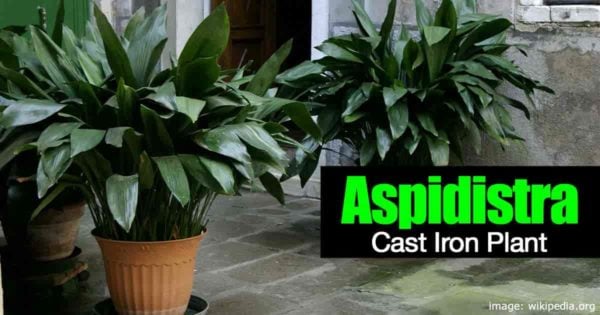
It can survive in public spaces like offices, shops, and doctor’s offices. This is especially true even when they may be neglected.
The plant is non-toxic and contains no harmful components, so it’s safe for cats to be around.
But, it’s important to keep the soil and pot of the plant out of reach of cats to avoid ingestion.
When exposed to the plant, cats may experience skin irritation from allergies.
Moreover, this cat-safe houseplant is also easy to care for.
You can check out our detailed guide on Cast Iron Plant Care: How To Grow Aspidistra Elatior.
Bamboo (subfamily Bambusoideae)
Bamboo is attractive, easy to grow, and can be propagated easily.
Many bamboo varieties can be kept as affordable houseplants, even though they can spread and become forests outdoors.
While bamboo may be attractive to cats as a member of the grass family, it won’t harm them.
Bamboo is not toxic to cats, but it’s important to keep it out of their reach to prevent ingestion.
Consuming large amounts of bamboo leaves or stems may cause cat digestive issues. It can lead to vomiting or diarrhea.
Prayer Plant (Maranta)
The Prayer Plant (Maranta leuconeura) earned its name for its leaf-closing behavior. It resembles hands in prayer at sundown.

The plant thrives in low-light environments and is generally light-sensitive.
While non-toxic to cats, its fibrous leaves can cause digestive issues if ingested in large amounts.
To prevent gastrointestinal problems, it’s best to keep the plant out of reach of cats.
To create a safe environment for your cat and your prayer plant, keep the plant out of your cat’s reach.
You can place your Maranta leuconeura where your cat cannot nibble on its leaves. Protective measures like placing it in a hanging basket or a plant barrier are also good options.
For more information on cat safety, check out “Are Prayer Plants Cat Safe?“
To learn more about growing prayer plants, here’s our guide: “How To Grow and Care For Prayer Plants.“
Indoor Palm Trees
Many palm varieties are safe for cats and make excellent houseplants.
Here are four of the best choices.
- Areca Palm (Dypsis lutescens)
Areca Palm has pretty fronds that create a tropical atmosphere in bright rooms.
It requires ample bright, indirect light and well-draining soil. Don’t forget to allow soil to dry out between thorough waterings.
While not toxic, monitoring your cat’s interaction with the plant is still advisable. It can cause vomiting or diarrhea, especially if consumed in large amounts.
Parlor Palm is a popular and affordable plant that thrives in home or office settings.

The plant loves consistent, comfortable room temperatures, bright indirect sunlight, and regular watering.
Although non-toxic to cats, ingestion of Parlor Palm can cause gastrointestinal discomfort. Symptoms include vomiting and diarrhea.
The Bamboo Palm is a safe houseplant for cats. This makes it a popular houseplant choice for cat owners who want to have greenery in their homes.

This South American native does well in shaded rooms with plenty of water. It’s commonly found in malls, offices, and houses.
Bamboo Palm is safe and non-toxic to cats. Cats also avoid eating the Bamboo Palm because of the toughness of its leaves.
Ponytail Palm is an attractive and unique houseplant. It features a thick trunk and cascading leaves resembling a ponytail.

Although not a true palm, it is often referred to as one. It thrives in bright light and low water conditions.
Ponytail Palm is safe for cats and poses no significant threat if ingested.
But while these palm plants are generally non-toxic, always check your cat’s interaction. Also, prevent excessive plant material consumption, which can cause digestive issues.
Asparagus Fern (Asparagus aethiopicus syn. Asparagus densiflorus)
While not a true fern, the Asparagus fern plant has a fern-like appearance. It’s also suitable for indoor settings with moderate, indirect lighting.

Avoid exposing the plant to excessive light, as it can cause the fronds to turn brown and die.
In the spring, tiny, inconspicuous flowers may appear.
Water the plant and allow it to dry almost completely before watering again.
While the asparagus fern is not highly toxic to cats, it can still cause issues if ingested.
The fronds or leaves contain sap that can cause allergic dermatitis in cats. It can lead to skin irritation, redness, itching, swelling, or blisters when in contact with it.
Also, consuming asparagus fern berries in large quantities can pose a risk to cats.
Plants Safe for Hanging Baskets:
Baby Tears Plant (Soleirolia soleirolii)
The baby tears plant earned its nickname after its tiny teardrop-shaped leaves. It’s a defining characteristic of this compact plant.

Planting outdoors in conducive settings makes a pretty and delicate creeping ground cover.
Kept as a houseplant, it can do well in a small hanging basket or as an addition to your terrarium.
While the plant has low toxicity, always prevent your cats from chewing or ingesting it.
The plant has saponins, which can be toxic to cats if ingested in large quantities.
Ingesting enough amounts of saponins can cause vomiting and diarrhea.
Burro’s Tail (Sedum morganianum)
The Burro’s Donkey Tail is named for its resemblance to a donkey’s tail. The plant is a succulent native to Honduras and Southern Mexico.
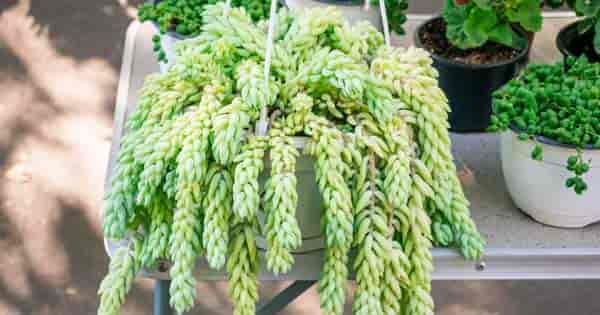
The plant has compact, bluish-green leaves that grow around the stems, creating a tail-like appearance.
While the tails of this plant can grow up to 3 feet long, it’s uncommon for them to achieve that length as houseplants.
Burro’s Tail thrives when grown in hanging baskets.
Although this succulent is non-toxic to cats, it’s best to prevent them from chewing on plants. Ingesting large amounts of the plant can lead to gastrointestinal issues in cats.
Polka Dot Plant or Freckle Face (Hypoestes phyllostachya)
The Polka Dot Plant is a tropical sub-shrub native to Madagascar. It’s known for its attractive oval green leaves. Its leaves also feature colorful lavender, pink, or rose splashes.

Throughout the summer, the plant produces tiny lilac-colored flowers.
While the Polka Dot Plant is non-toxic to cats, different cats may be sensitive to the plant. So, always check your cat’s behavior around the plant.
Mosaic Plant or Nerve Plant (Fittonia spp.)
Fittonia is a cat-safe spreading evergreen houseplant. It features deep green, veined leaves in shades ranging from white to silver to pink or green.

This low-growing creeper is a good choice for a bottle garden or a terrarium.
It likes a low light setting and moderate watering.
The Mosaic Plant is generally safe for cats and is a non-toxic plant.
Houseplants Providing Environmental Enrichment and Mental Stimulation:
African Violet (Saintpaulia)
African Violets come in various types, which creates a beautiful and diverse collection.

These plants have deep green fuzzy leaves with purple highlights.
Blooms come in various shades ranging from white to pink to deepest purple.
African Violets need consistently warm temperatures and bright, indirect light to thrive. The plant also needs occasional deep drenching after the soil dries almost completely.
African Violets are generally safe for cats and considered non-toxic. But ensure the plants haven’t been treated with harmful substances.
Also, be mindful of your cat’s potential sensitivities or allergies.
Moth Orchids (Phalaenopsis)
Orchids of all sorts are found in a wide variety of shops worldwide.

Of all the orchids, the Phalaenopsis is the easiest to grow.
This non-fussy plant likes lots of bright, indirect sunlight. It also needs weekly soaking in filtered, bottled, or rainwater.
Once every six weeks or so, provide a feeding of orchid fertilizer.
Moth Orchids are generally considered safe for cats. But while non-toxic, ensure they are not treated with herbicides or pesticides.
These chemicals can cause vomiting or other health issues if ingested by cats.
Venus Fly Trap (Dionaea muscipula)
Carnivorous plants, like the Venus Fly Trap, are exotic and need minimal care.
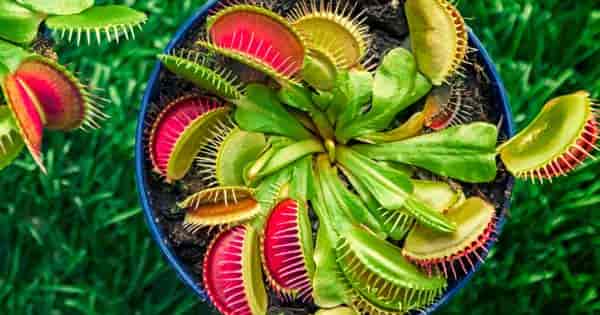
It’s best to provide your plant with four hours of direct sunlight. It also needs pure water (distilled, filtered, or rainwater). Adding nutrient-poor substrates like sphagnum or peat moss will also help.
Contrary to popular belief, Venus Fly Traps don’t need a lot of flies. An occasional meal is enough.
Moreover, Venus Fly Traps are generally considered safe for cats.
But be aware of potential risks. Cats may be curious about the trap’s movement or the plant’s unique appearance.
A curious cat could trigger the trap by touching the trigger hairs.
But even if the trap snaps shut on a cat’s paw or nose, it only captures small insects and won’t cause harm or injury to the cat.
Zebra Plant or Peacock Plant (Calathea spp.)
Calathea plants, called Zebra Plants, are known for their large leaves. They feature vibrant stippling or stripes ranging from deep green to gold, pink, or purple.

These plants thrive in shady corners and display more attractive colors.
But exposure to excessive sunlight can cause the colors of the leaves to fade.
Calathea is generally safe and non-toxic for cats. If a cat ingests any part of the Calathea plant, it won’t harm your pet.
Friendship Plant (Pilea involucrata)
The Friendship Plant is a trailing plant native to Central and South America.
It thrives in a sheltered place with high humidity, making it a great terrarium plant.
The plant features quilted leaves in a bright shade of apple green with dark bronze veins.
The Friendship Plant is safe for cats and considered non-toxic. If a cat touches or eats any part of the plant, it’s unlikely to result in harm or toxicity.
Non-toxic, Non-Allergenic, Pet-Safe Houseplants:
Christmas Cactus (Schlumbergera bridgesii)
Christmas Cactus is an interesting addition to any plant collection.

It makes a lovely green plant through the spring and summer months. It blooms with pretty white, pink, or red flowers during the holiday season.
The plant makes a good choice for a hanging basket but is often kept as a tabletop plant.
Christmas cactus is generally safe and non-toxic to both cats and dogs. But consuming Christmas cactus leaves, flowers, and stems may cause intestinal blockage.
The plant parts are non-digestible, which can lead to a serious medical situation.
Peperomia
There are many different types of Peperomia, and all make lovely houseplants.

All have thick, interesting leaves in shades of deep green, purple, and cream.
The peperomia emerald ripple variety is an attractive one.
Examples of other noteworthy species are:
- Peperomia obtusifolia (Baby Rubber plant)
- Peperomia argyreia (Watermelon peperomia)
They are ideal for tabletop areas with moderate, indirect sunlight.
These plants are also easy to cultivate and propagate.
Peperomia plants are generally non-toxic and classified as safe for cats and dogs.
However, the plant’s thick and fleshy leaves may entice cats who enjoy chewing on them.
While Peperomia is usually non-toxic, ingesting many leaves can cause stomach upset.
Gerbera Daisy (Gerbera jamesonii)
The Gerbera daisy is a resilient South African native standing over a foot high. It’s hardy and does well in partial to full sun settings.

These dramatic plants feature big, bold, daisy-like flowers in white, yellow, orange, salmon, and pink.
Gerbera Daisies are generally non-toxic and considered safe for cats. But cats can have different tolerances to certain plants.
It can cause stomach upset or allergic reactions if ingested in large quantities.
Cats with digestive sensitivities can experience vomiting, diarrhea, or loss of appetite.
Plants Suitable for Beginners:
Money Tree (Pachira aquatic)
The Money Tree is a swamp plant native to Central America and South America.

Also known as the Money Plant, it’s considered an “air cleaning” plant and can tolerate poor air quality.
These plants are believed to bring prosperity and good luck to homes.
Money Trees are generally safe for cats, as they are not poisonous. But it can cause symptoms like vomiting, diarrhea, or loss of appetite if ingested.
Related: Growing the Money Tree
Spider Plant (Chlorophytum comosum)
The spider plant is a popular hanging houseplant. It comes in solid green or green and white striped varieties.

The airplane plant produces plantlets that can grow and dangle from a hanging pot. It can also be separated to create new individual plants.
Spider Plants are non-toxic to cats and are often cultivated as a food source in Africa.
While safe for cats, these plants contain chemicals that may cause a slight hallucinogenic effect.
Ingesting large amounts of the plant can also lead to an upset stomach and digestive issues in cats.
Related: Growing Chlorophytum Comosum – Spider Plant Care
Boston Fern (Nephrolepis exaltata bostoniensis)
Boston Ferns are fast-growing plants that thrive in rooms with bright, indirect lighting and high humidity.

A bathroom skylight is perfect for this plant, which needs plenty of room to cascade and dangle.
While Boston Ferns are generally safe for cats, it’s important to be cautious of the plant’s fronds.
The fern’s leaf surface contains tiny, hair-like structures called trichomes. It may irritate the mouths or digestive systems of sensitive cats.
Although the plant is not toxic, ingesting large amounts can lead to vomiting or diarrhea.
Here’s where you can learn more about Boston Fern Care
Wandering Jew (Tradescantia Zebrina)
This purple version of the Wandering Jew makes a pretty addition to a windowsill or high shelf.

It has a rambling, spreading growth habit, doing well in a hanging basket.
While Wandering Jew is generally safe for cats, it’s important to know its potential risks.
The plant contains calcium oxalate crystals and alkaloids in its sap. Cats may experience vomiting, diarrhea, and even seizures after ingesting the sap.
Wax Plant or Porcelain Flower (Hoya)
Hoya is a nearly indestructible plant with attractive, glossy, thick waxy leaves.

It’s resistant to bad air quality and can live decades in less-than-perfect situations.
The plant can grow huge, producing pretty, sweet-smelling flowers in the springtime.
Several Hoya varieties to choose from:
Wax Plant is generally considered safe for cats. Always check your cat’s behavior around these plants. Some cats may react differently and exhibit allergies or sensitivities.
Swedish Ivy (Plectranthus australis)
The attractive Swedish ivy plant is not an ivy at all). It thrives at regular room temperature with plenty of indirect sunlight.

This popular houseplant is excellent for a beginner because it requires little care.
Like most ivy, it does well in a hanging basket where it can spread and cascade.
Swedish Ivy is a non-toxic plant for cats. But playing with or chewing on it may cause vomiting or diarrhea if consumed in large quantities.
Other Cat-Safe Houseplants:
Gloxinia (Sinningia speciosa)
These plants are easily obtained on all popular holidays, such as Mother’s Day and Valentine’s Day.
These natives of Brazil prefer comfortable room temperatures, consistent moisture, and indirect sunlight.
They produce plenty of beautiful, bi-colored flowers in the springtime.
Gloxinia plants are generally non-toxic to cats. But ingesting Gloxinia leaves or flowers may cause vomiting or diarrhea.
Banana Leaf (Musa)
The banana tree plant is a safe choice for households with cats if you want a large and dramatic plant. Its leaves are bold, large, and deep green.

When caring for Banana Leaf Plants, ensure they are kept in rich soil and receive regular watering. These plants thrive in bright light conditions.
In small amounts, bananas are generally safe for cats to eat. The fruit is not toxic to cats. Instead, it provides vitamins B6 and C, potassium, and carbohydrates.
But cats do not usually consume banana leaves, which may cause vomiting or diarrhea.
Also, certain banana plant parts, like the leaves, contain a high amount of oxalates. In high doses, oxalates can be toxic to cats and may cause damage to their kidneys.
Echeveria
The Echeveria plant family consists of many different rose-shaped succulents. All are native to semi-desert regions in Central America.

These succulents are popular, both for their attractive appearance and ease of care.
In the spring and summer, they produce lovely flowers.
Echeveria plants are generally safe for cats but may contain mild toxins.
Prevent cats from ingesting large amounts to avoid gastrointestinal upset or other symptoms.
Bromeliad (Bromeliaceae)
There are many different types of Bromeliads, which are all interesting and unusual.
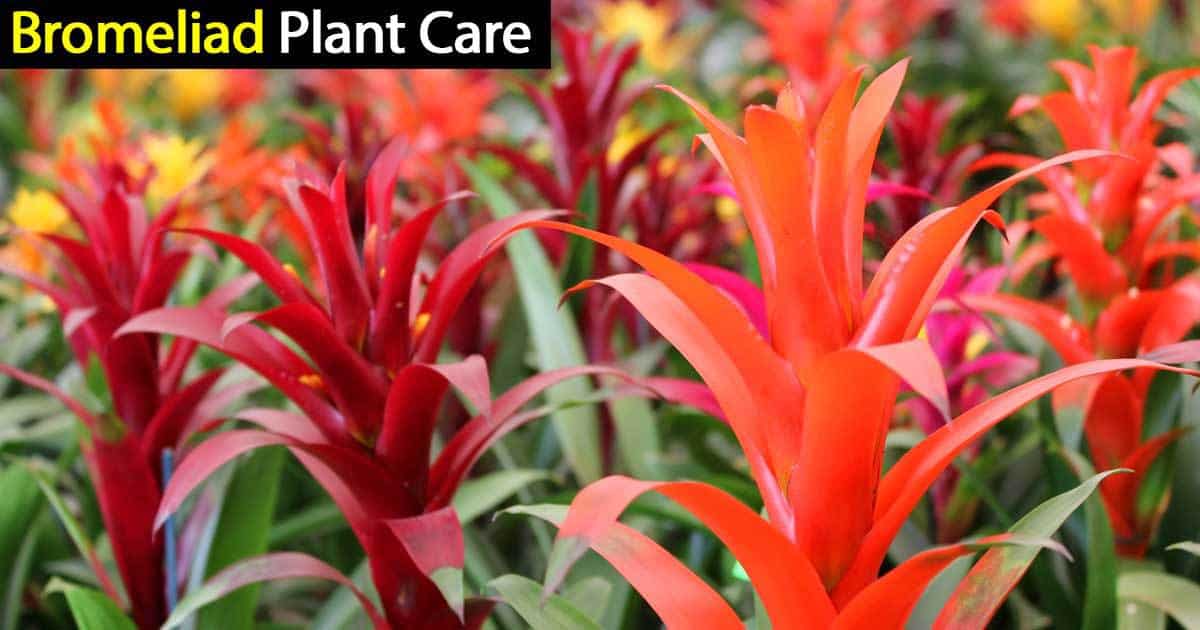
They have strong, strappy leaves and odd, cone-shaped flowers.
These epiphytes are easy to care for and grow soil-free by anchoring them to a bit of driftwood. Most people also maintain them as an air plant.
In general, most types of bromeliads are non-toxic to cats. However, some cats may have allergies or sensitivities to these plants.
Common allergy symptoms in cats include sneezing, coughing, and skin irritation.
Purple Waffle Plant (Hemigraphis alternata)
The Purple Waffle is a pretty plant with highly textured purple leaves. These leaves produce the best color in a setting, providing bright, indirect lighting.
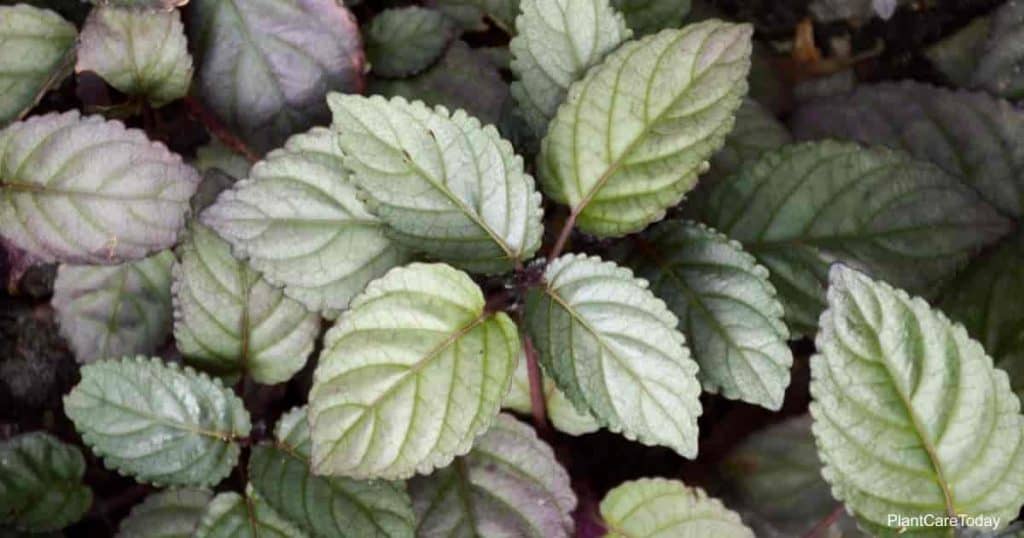
The plant prefers evenly moist, well-draining soil and plenty of humidity.
Purple Waffle Plant has no toxins that could cause vomiting, diarrhea, or skin irritation.
So, it’s a safe option for pet owners worried about their cats’ safety around houseplants.
But while these plants are generally safe for cats, there may still be potential risks.
Some cats may have allergies to this plant, which could lead to sneezing, coughing, and runny eyes.
Purple Passion Plant (Gynura aurantiaca)
Gynura aurantiaca is an interesting houseplant with a thick purple fur coat on green leaves.

The velvety hairs grow thick and shiny when the plant is kept in a bright light setting.
In the springtime, Purple Passion plants produce strange-smelling orange flowers.
The Purple Passion plant thrives in bright light conditions. It also prefers to be watered sparingly, waiting until the soil is dry before watering.
Purple Passion Plant is generally considered non-toxic to cats. But the cats’ carnivorous nature makes them less capable of processing plant materials. Excessive consumption of the plant may lead to digestive issues.
Haworthia Succulent or Zebra Cactus
The Haworthia plant is a low-growing succulent that is safe for cats. It resembles aloe vera in appearance but has its own unique characteristics.

One popular variety is the Zebra Cactus. It has fleshy, green, spear-like leaves with white bands or raised dots like a zebra’s stripes.
The Haworthia plant should be placed in a bright light setting to ensure it remains healthy.
During the summertime, regular watering is essential to keep the plant hydrated. However, in the winter, it’s advisable to reduce watering as the plant goes into a period of dormancy.
Haworthia Succulent is generally non-toxic to cats. But, like any plant, consuming large quantities can cause gastrointestinal upset.
Preventing Health Issues Related to Houseplants and Cats
Houseplants are a popular way to beautify your home. But, many common houseplants can be toxic to cats if ingested.
To help keep your furry friend safe and healthy around indoor plants, follow these tips:
Choose cat-safe plants
Research indoor plants safe for cats and dogs to ensure the safety of your furry friend.
Some examples include:
- Spider Plant
- African Violet
- Boston Fern
- Nest Fern
- Calathea Orbifolia
- Ribbon plant
- Chinese money plant (Pilea peperomioides)
- Staghorn fern
- Bamboo Palm
Avoid highly toxic plants to cats:
- Monstera (Swiss cheese plant)
- Date Palm
- Lilies
- Daffodils
- Tulips
To learn more about plant safety, refer to The American Society for the Prevention of Cruelty to Animals (ASPCA).
Monitor your cat’s behavior
Observe your cat’s interaction with plants when introducing a new one into the house. Limit your cat’s access to plants if they show excessive interest or if your cat is prone to chewing on objects.
Ensure a healthy, balanced diet
A well-balanced diet will support your cat’s health. It will also make them less prone to ingest non-food items like plants out of curiosity.
Recognize plant toxicity symptoms
Be aware of potential symptoms of plant poisoning in cats, including:
- Vomiting
- Diarrhea
- Lethargy
- Decreased appetite
- Difficulty breathing
- Seizures
If you recognize any of these symptoms, seek veterinary advice immediately.
Take action for severe toxic reactions
Some toxic plants can lead to severe symptoms that need hospitalization or therapies.
If your cat shows signs of severe symptoms, take your cat to the vet as soon as possible. Signs may include difficulty breathing and seizures.
Providing Your Cats With Enrichment and Mental Stimulation
Enrichment and mental stimulation are crucial for cats’ physical and emotional well-being.
Outdoor exploration and playtime are great sources of stimulation. But indoor enrichment through houseplants can also offer a safe and beneficial alternative.
Here are some ways in which houseplants can provide mental stimulation for cats:
Interactive plants
Selecting plants that engage cats can be beneficial for their mental stimulation.
Plants that mimic the motion of prey can excite cats and trigger their hunting instincts. An example of an interactive plant is a Spider Plant.
Catnip and Cat Grass can also be sources of entertainment, as cats can nibble on them, roll around, and play.
Natural environment
Cats are naturally drawn to anything that mimics their outdoor environment. Houseplants that provide hiding spots or climbing opportunities can be stimulating for cats.
They will enjoy larger plants like Palm trees and ferns that create a jungle-like atmosphere.
Scent
Cats have a highly developed sense of smell and can be stimulated through scents. They enjoy plants like Rosemary, Lavender, and Mint with strong and appealing smells.
These scents can help calm your cat or provide an extra sensory experience.
Visual stimulation
Visual cues also stimulate cats. Plants with different textures, shapes, and colors can provide a visual experience.
Plants with unique leaf patterns can provide an exciting and attractive visual component. Examples are the Calathea or Rattlesnake plant.
The movement of leaves on a Ficus Tree can also be a great source of entertainment for cats.
Creating a Cat-Friendly Home Environment
When selecting cat-friendly houseplants, it’s essential to focus on your pet’s safety.
Here’s a guide to help you create a cat-safe environment:
Placement of plants

Place your houseplants out of your cat’s reach. Hang baskets from secure hooks or use elevated shelves or plant stands.
Creating barriers will prevent your cat from accessing the plants. It will also reduce the risk of nibbling or knocking them over.
Potting considerations
Choose sturdy pots made of ceramic or metal. Doing so will avoid breakage if accidentally knocked over. Also, avoid plastic pots that cats may chew on.
Moreover, be cautious with potting soil and fertilizers. Opt for pet-safe soil and organic fertilizers.
Be aware of toxic parts
Research each plant and identify which parts are toxic to cats.
Ensure these parts are not accessible to your cat. Trim or remove any toxic parts if necessary.
Pay attention to trailing plants or with tendrils that may tempt your cat to chew.
Create a barrier
Use mesh, wire, decorative fencing, or repurposed baby gates if your cat is persistent. Doing so will enclose your plants and prevent your cat from reaching them.
Provide alternatives
Offer safe alternatives such as cat grass to deter your cat from chewing on houseplants.
It satisfies their urge to nibble and keeps them away from harmful plants.
Increase vertical options
Cats love to climb and explore. Provide vertical options like cat trees, shelves, or window perches. It will redirect their attention and engage them in cat-appropriate activities.
Questions and Answers
Are there any safe houseplants for pets that effectively filter indoor air?
Yes, several safe houseplants for pets are particularly effective at filtering indoor air.
Some of the best air-purifying plants safe for pets include:
- Boston fern
- Spider plant
- Bamboo palm
- Areca palm
- Peace lily
These plants remove formaldehyde, benzene, and other air pollutants in homes and offices.
Other pet-safe plants good at removing harmful pollutants include:
Are there specific cat-safe fertilizers or techniques you recommend for feeding my houseplants?
Opt for organic and natural fertilizers, as they are safer for pets. Look for fertilizers labeled as pet-friendly. You can also look for fertilizers mentioned as safe for use around animals.
Consider using slow-release fertilizers that release nutrients over time. These fertilizers reduce the risk of accidental ingestion since they are applied less.
You can use natural soil amendments such as compost or organic matter. These help enrich the soil and provide plant nutrients without harming your pets. Avoid concentrated liquid fertilizers.